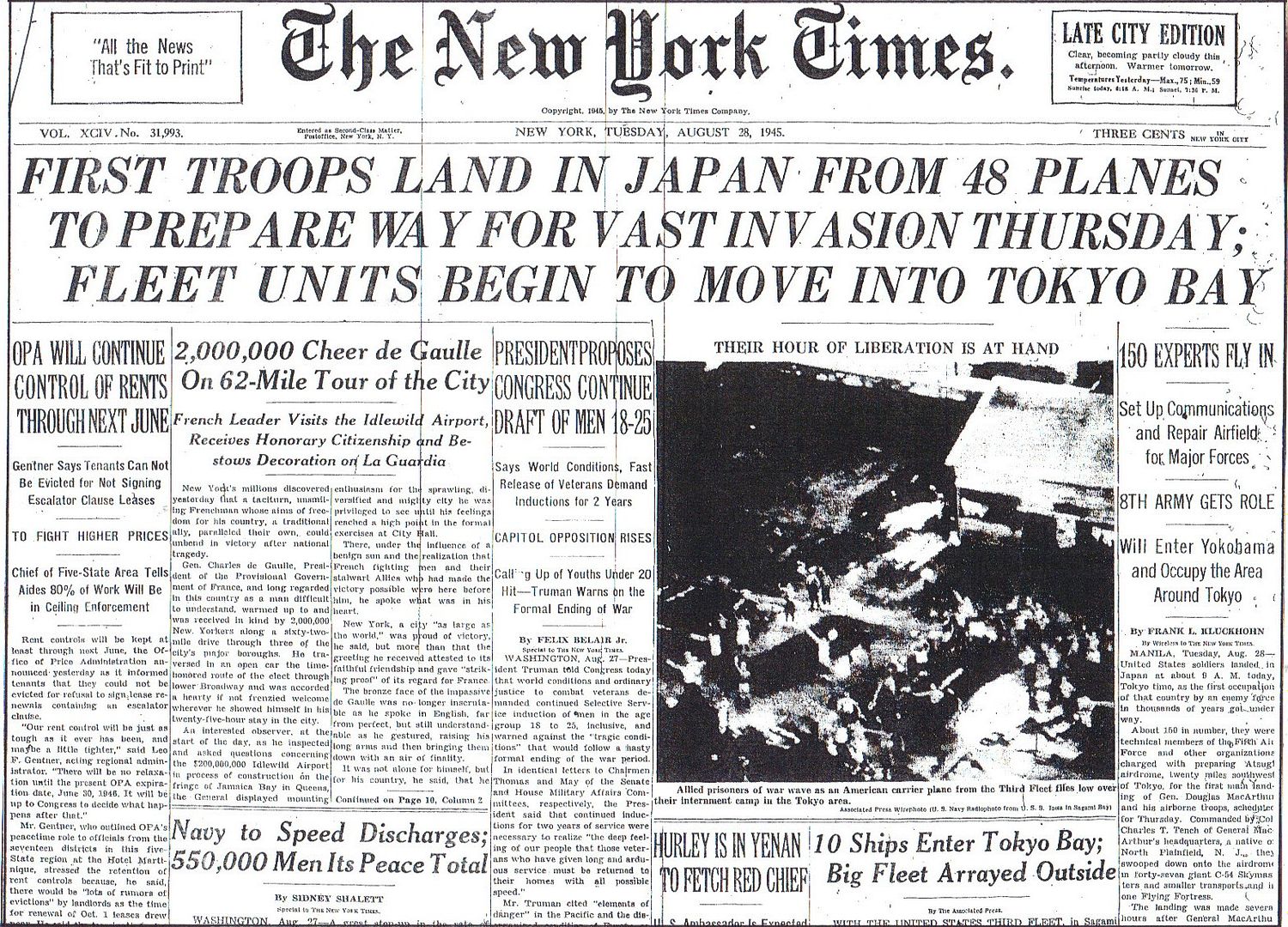
Posted on 08/28/2015 4:39:38 AM PDT by Homer_J_Simpson

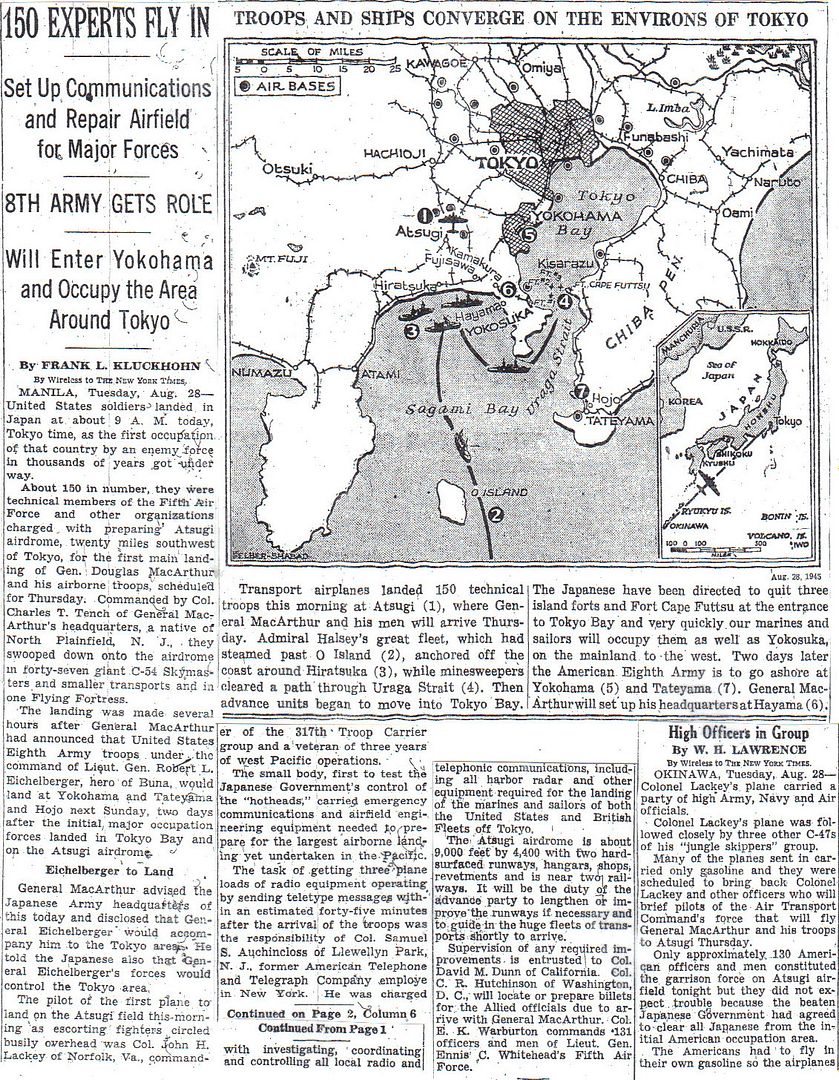
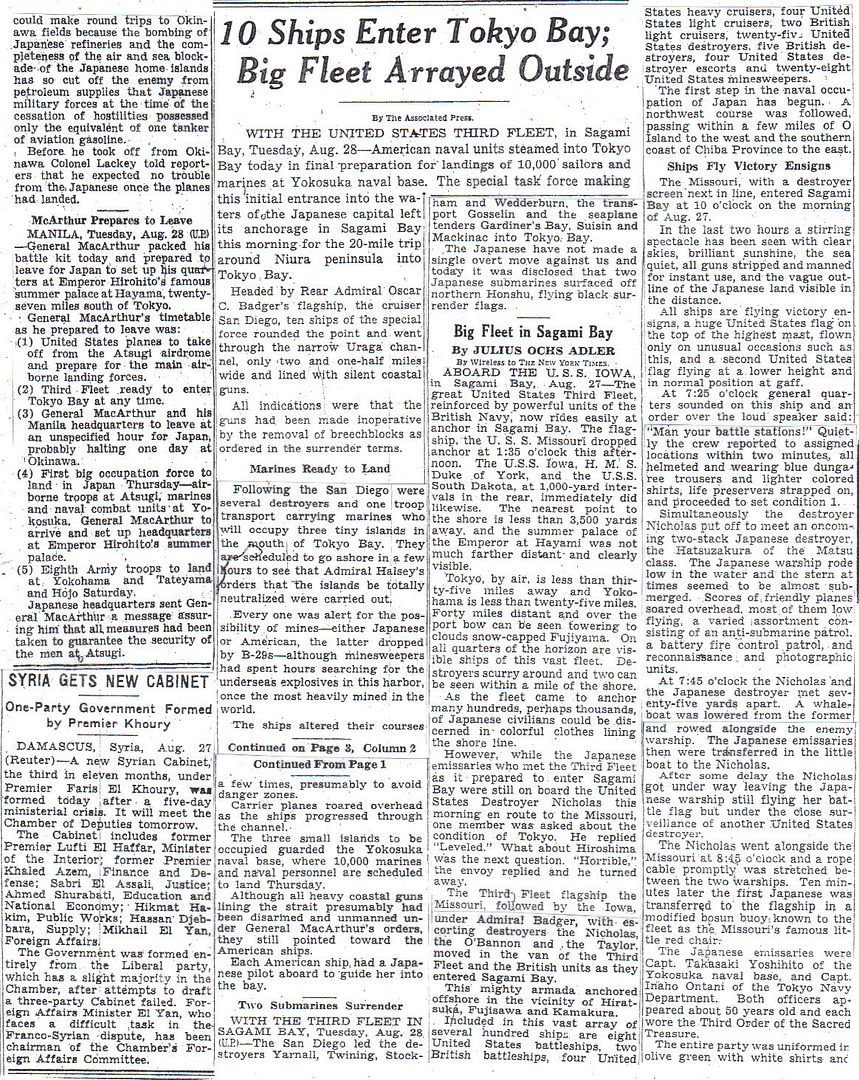
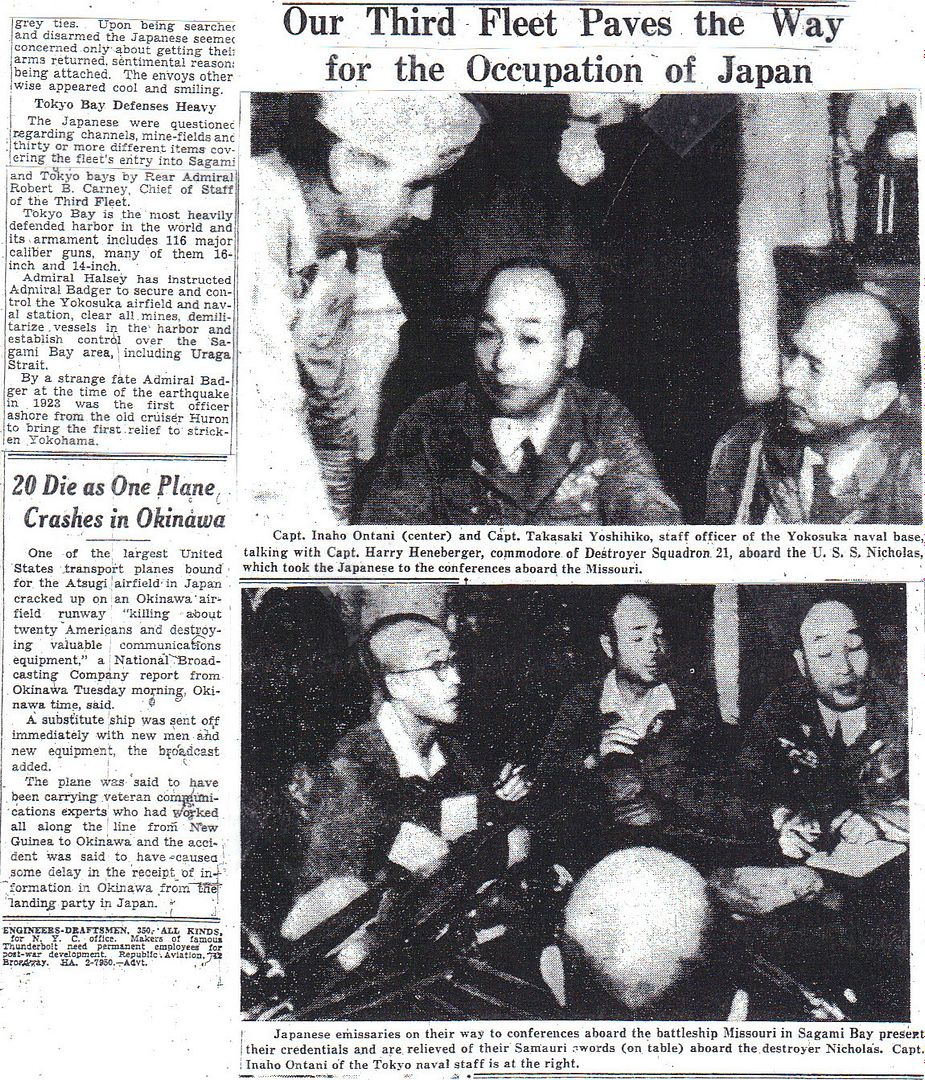
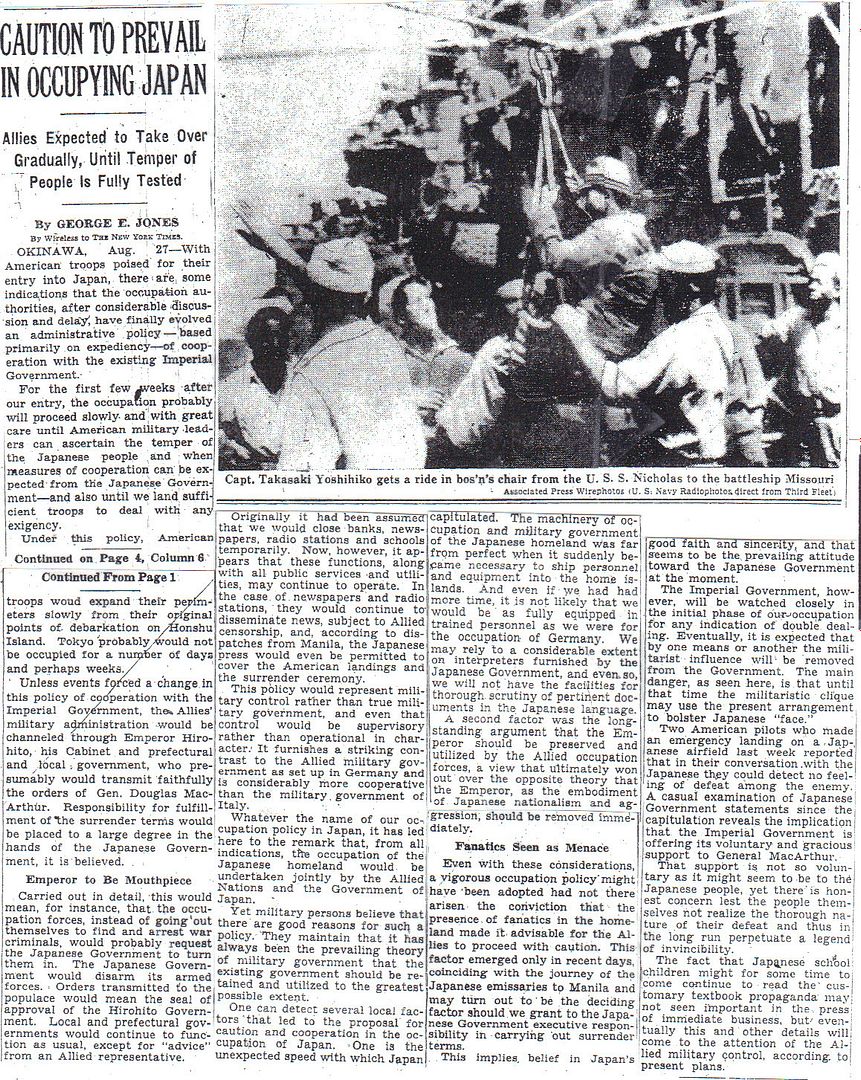
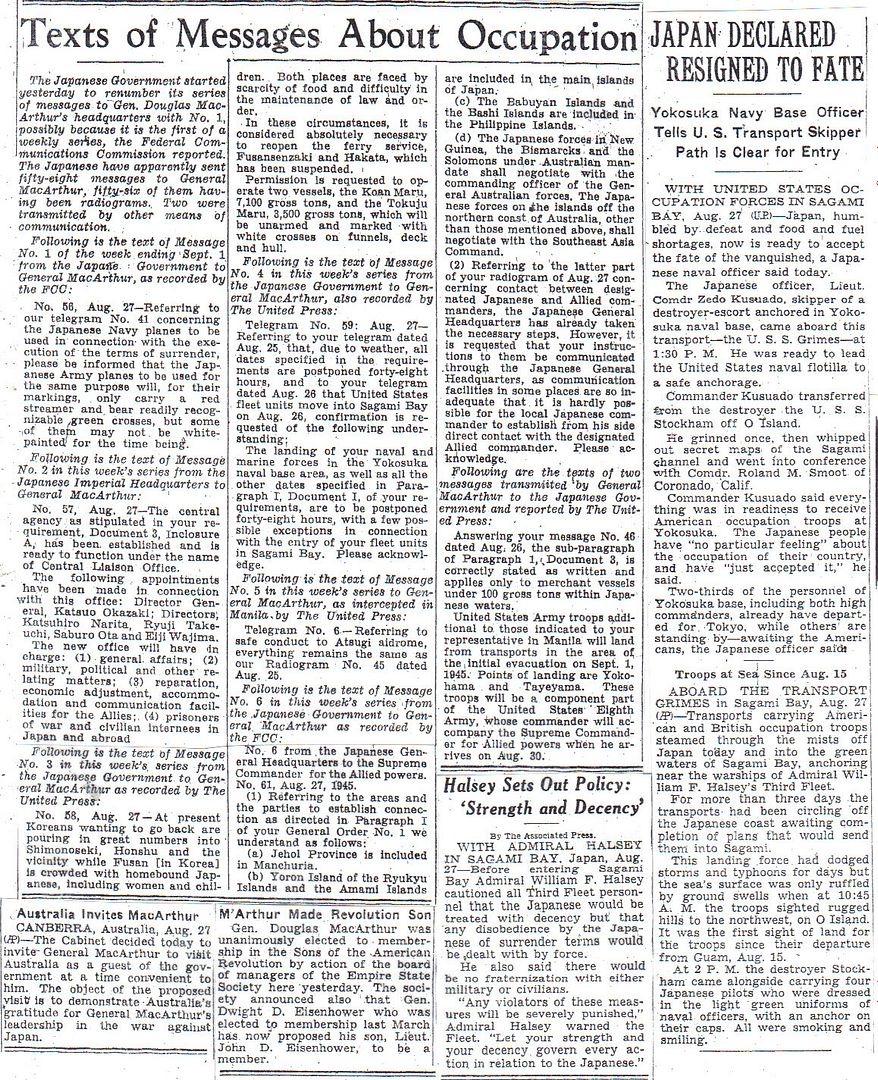
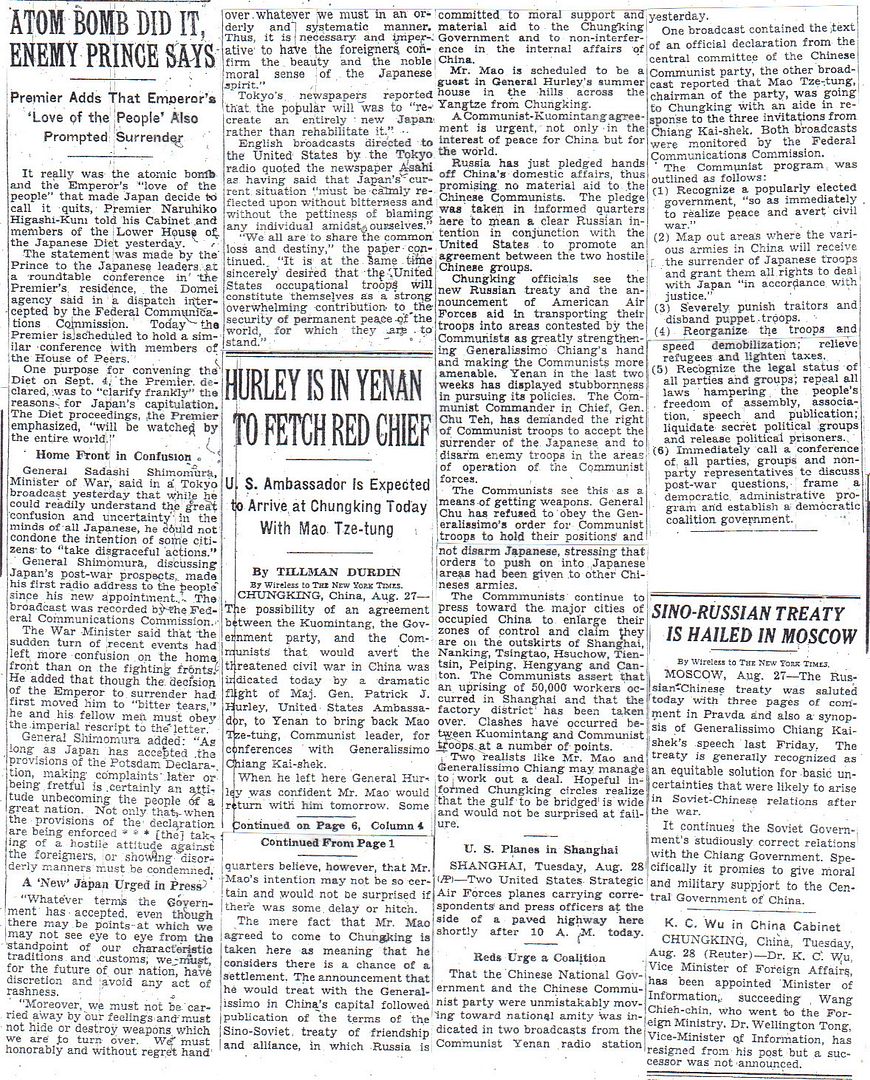
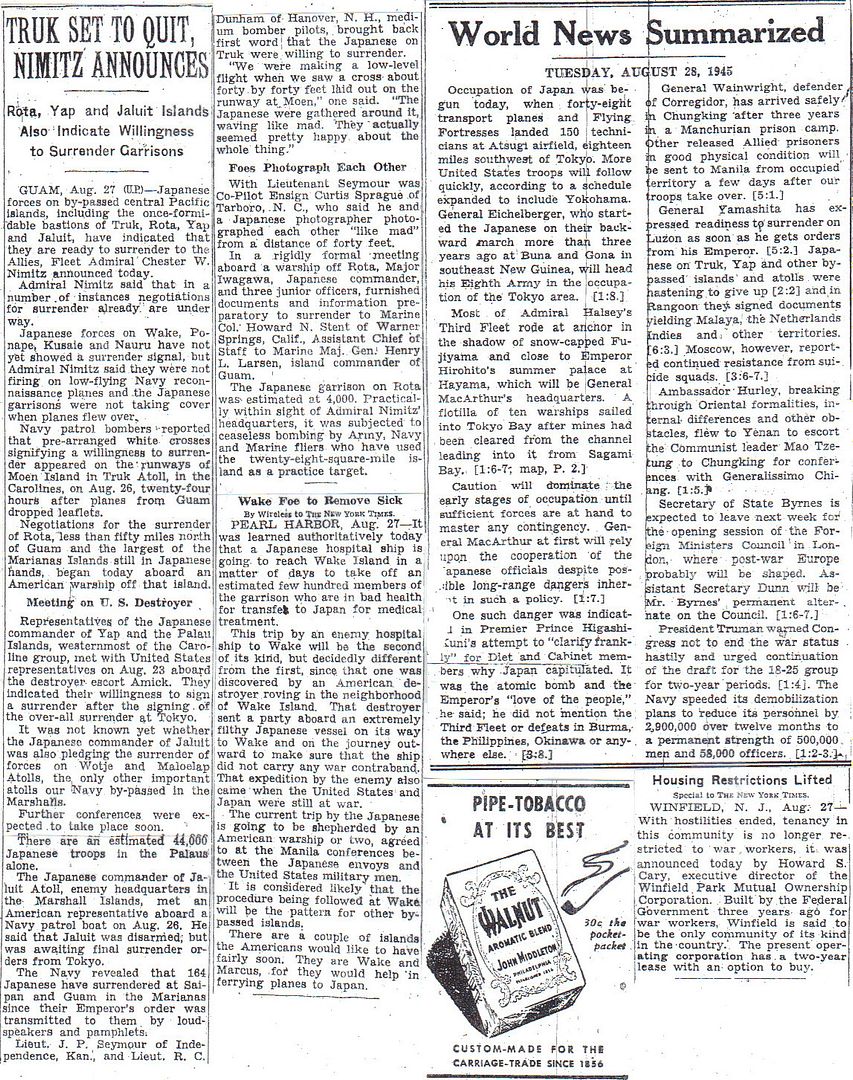
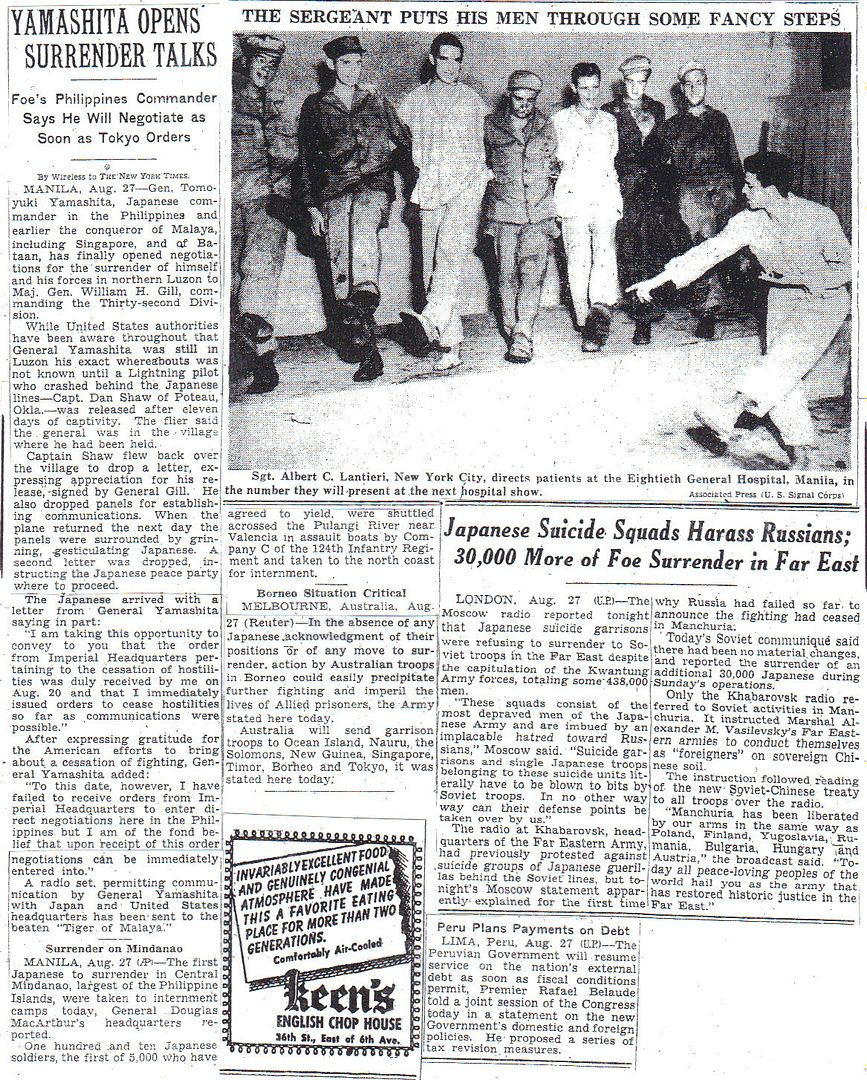
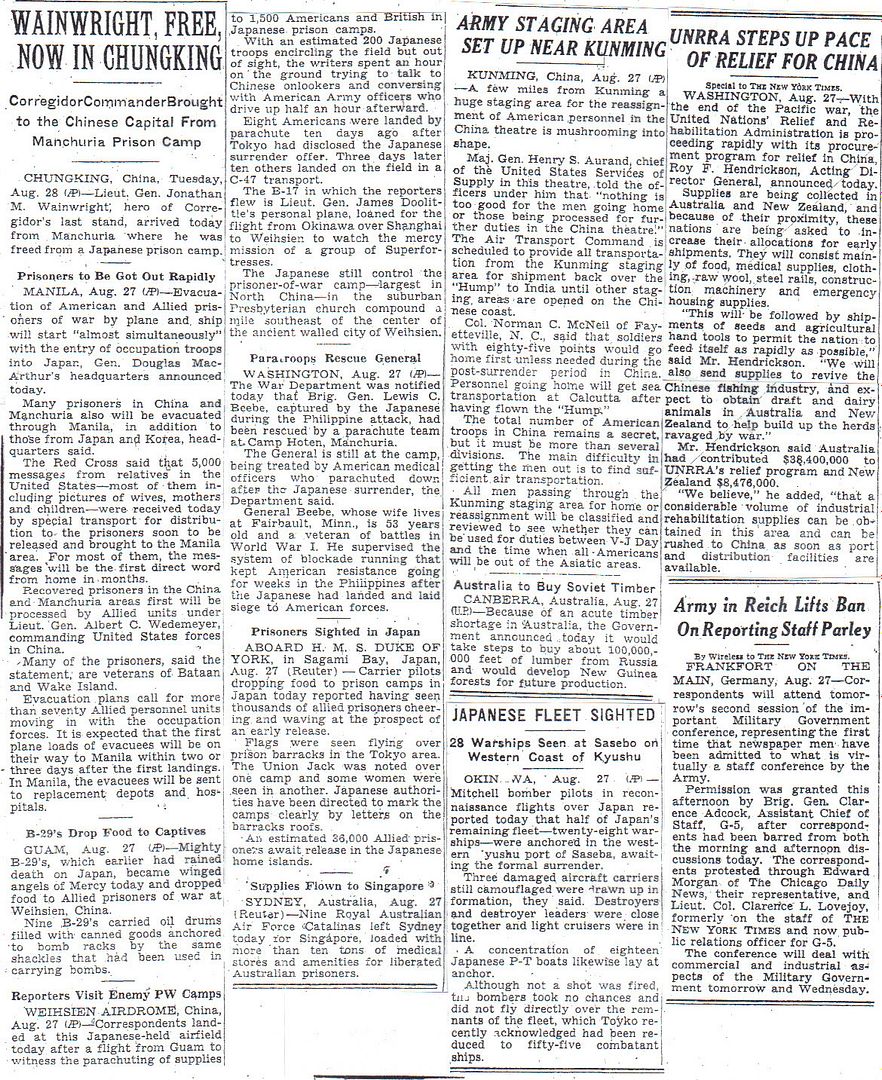
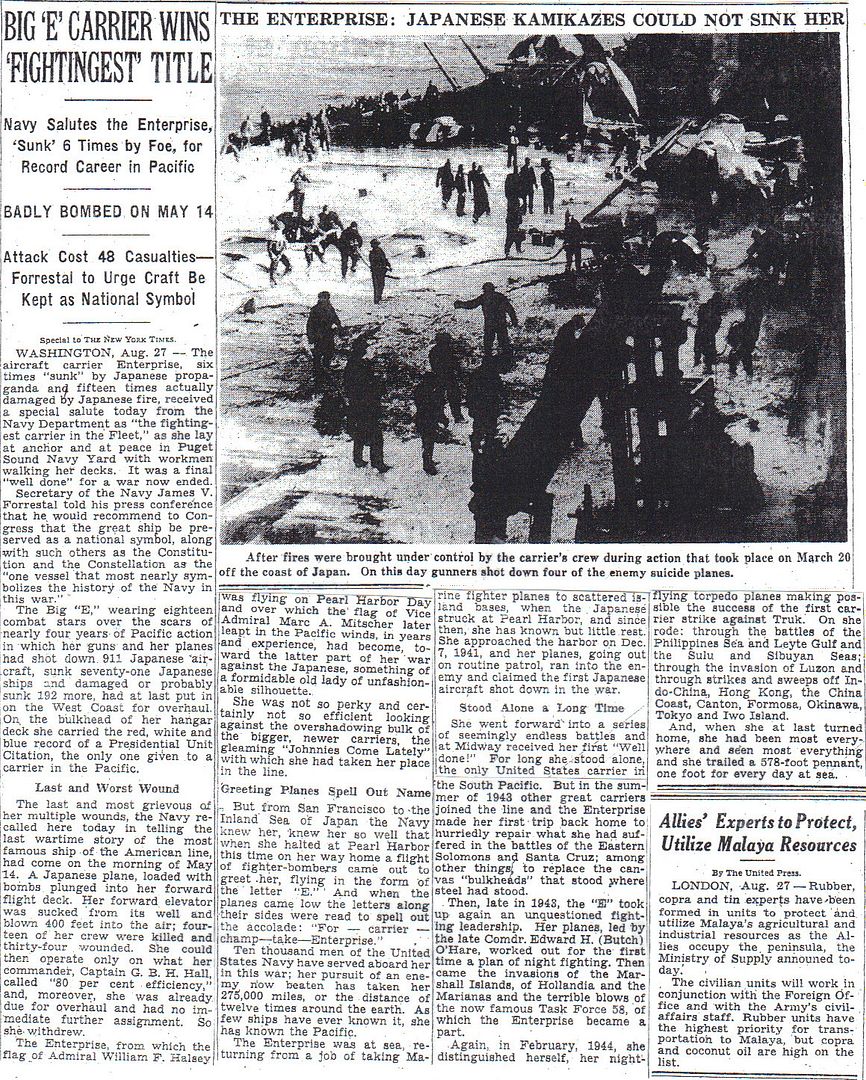


John Toland, The Rising Sun: The Decline and Fall of the Japanese Empire, 1936-1945
http://www.etherit.co.uk/month/7/28.htm
August 28th, 1945 (TUESDAY)
GERMANY: Nuremburg: The Nazis Party’s “jovial brute”, Hermann Göring , heads the first list of 24 German war criminals. Hess, once Hitler’s deputy, who has been a prisoner in Britain sice May 1941, is next in line, followed by Martin Bormann, Hitler’s last deputy, who vanished from the Berlin bunker and has not been seen since. The many civilians indicted include Baron Konstantin on Neurath, Hitler’s first foreign minister; Gustav Krupp von Bohlen, the industrialist; Franz von Papen, Hitler’s vice-chancellor in 1933-34, and Hjalmar Schacht, the financial wizard who fell out with Hitler after serving as a minister.
BURMA: Japanese forces in Rangoon sign a formal surrender.
FRENCH INDOCHINA: In Vietnam, the Viet Minh form a provisional government of the Democratic Republic of Vietnam with Ho Chi Minh as president, Vo Nguyen Giap, as interior minister and Pham Van Dong, as finance minister.
In Laos, Prime Minister Prince Phetsarath wires provincial governors notifying them of the Japanese surrender. The Prince further declares that the proclamation of independence is unaffected and that the governors should resist any attempts at foreign intervention in their administration. The French Resident Superieur is released from prison but Phetsarath refuses to recognize his authority.
CHINA: Communist leader Mao Tse-Tung arrives in Chunking to confer with Nationalist leader Chiang Kai-Shek in a futile effort to avert civil war.
JAPAN: The occupation of Japan officially begins as an advance party arrives in the Home Islands. When the news of the Japanese proposal for surrender came on 15 August, the USAAF’s 68th Army Airways Communications System (AACS) Group, 7th AACS Wing, received orders to fly into Atsugi Airfield near Tokyo and set up the communications equipment necessary to guide in the first contingent of occupation troops. AACS’s mission was to provide navigational aids, point-to-point communications with Okinawa, air-to-ground communications for planes in flight, weather data, and air traffic control. Colonel Gordon Blake quickly assembled a special unit of 5 hand-picked men. Colonel Blake and his AACS men, part of a 150 man task force, flew from Okinawa to Atsugi with 24 C-47 aircraft laden with equipment. In order to carry as much equipment as possible, the load was lightened by carrying only enough fuel to reach Atsugi. Although the Japanese had surrendered unconditionally, Blake and his communicators still did not know whether some might still be hostile. The sight of hundreds of Japanese Navy guards lined up along the airfield was not encouraging to the occupants of the first aircraft to land, but they were met by a group of courteous, English-speaking Japanese military personnel. The first C-47 to land was piloted by Col. Edward Imparato. Col. Charles Trench is the first man off the aircraft.
The navy guards were in their honor. The AACS-men lost no time in getting operations into full swing, and by 29 August, the Atsugi control tower was completed. The first planes to arrive on 30 August were 5 additional C-47s carrying components to set up the first airborne radio station in USAAF history. Within a few hours, the first C-54 Skymaster aircraft of the official occupation forces landed at Atsugi and by mid-afternoon Blake’s AACS crews had directed 340+ takeoffs and landings at the rate of 1 every 2 minutes. On 30 August, Atsugi was the busiest airport in the world.
USN underwater demolition teams (UDT) land to check prospective Tokyo Bay landing beaches and ensure that fortification are neutralized.
Minesweepers begin clearing mines from Tokyo Bay.
Destroyers of the Royal Australian Navy joined Royal Navy and United States Navy ships in Tokyo Bay to receive the main Japanese surrender on 2 September.
In the air, the 386th Bombardment Squadron (Very Heavy), based on Okinawa, flies its last combat mission, a photo reconnaissance mission, with the Consolidated B-32 Dominator.
CANADA: Bangor-class minesweepers HMCS Brockville, Noranda (transfered to RCMP as MacLeod, Irvine) and Melville paid off.
Corvettes HMCS Sudbury and Shediac paid off Esquimalt, British Columbia.
Tropicalization refit for HMCS Sea Cliff cancelled Liverpool, Nova Scotia.
U.S.A.: Major league baseball commissioner Branch Rickey and future baseball great Jackie Robinson meet and discuss the difficulties Robinson, a black athlete, will face in major league baseball. Robinson had signed a contract with the Brooklyn Dodgers calling for a salary of US$600 a month (US$5,714 in year 2000 dollars) plus a US$3,500 signing bonus (US$33,333 in year 2000 dollars) to play for Montreal of the Triple A International League.
bookmark
I’m sure going to miss these come Sept. 2.
Come back on Sept. 3 for our last hurrah.
ATOM BOMB DID IT, ENEMY PRINCE SAYS
Premier Adds That Emperor’s “Love of the People’ Also prompted surrender.
Martin Bormann, Hitler’s last deputy, who vanished from the Berlin bunker and has not been seen since.
https://en.wikipedia.org/wiki/Martin_Bormann
Bormann returned with Hitler to the Führerbunker in Berlin on 16 January 1945 as the Red Army approached the city. After Hitler committed suicide, Bormann and others attempted to flee Berlin on 2 May to avoid capture by the Soviets. Bormann probably committed suicide on a bridge near Lehrter station. The body was buried nearby on 8 May 1945, but was not found and confirmed as genuine until 1972. Bormann was tried in absentia by the International Military Tribunal in the Nuremberg trials of 1945 and 1946. He was convicted of war crimes and crimes against humanity and sentenced to death by hanging
Over the coming years, several organisations, including the CIA and the West German Government, attempted to locate Bormann without success.[103] The West German government in 1964 offered a reward of 100,000 Deutsche Marks for information leading to Bormann’s capture.[104] Sightings were reported at points all over the world, including Australia, Denmark, Italy, and South America.[53][105] In his autobiography, Nazi intelligence officer Reinhard Gehlen claimed that Bormann had been a Soviet spy, and that he had escaped to Moscow.[106] Nazi hunter Simon Wiesenthal believed that Bormann was living in South America.[107] The West German government declared that its hunt for Bormann was over in 1971.[108]
USN underwater demolition teams (UDT) land to check prospective Tokyo Bay landing beaches and ensure that fortification are neutralized.
http://www.specwarnet.net/americas/UDT.htm
Most of the UDT Teams were marshalling in California in preparations for the planned invasion of the Japanese homeland when the war ended. Some were sent to Japane to aid in the occupation.
With Japan’s surrender in August of 1945, the majority of the UDT’s were shut down. There were a couple that continued to operate in the Pacific, helping allied forces occupy Japan and its former conquested lands. UDT-21 was the first American Forces to land on the Japanese homelands and received the first surrender, when Lieutenant Commander Edward Clayton accepted the sword , which was struck by USS Fullman and sunk. There was no loss of life, but as all of their equipment was lost with the ship UDT able did not take part and was sent back to Maui to be broken up and used to help form new UDT’s
Notes: formed by consolidating several NCDU’s that had been deployed to the South Pacific theatre
UDT
21 Activated: October, 1944
Deactivated:
History:
Okinawa invasion while attached to APD-79 USS Bunch and sailed for Japan. UDT-21 landed at Futtsu-misaki on the Japanese homeland island of Honshu on August 29, 1945. This was the first landings on the island by american naval forces and also the first surrender ceremony, with Lieutenant Commander Edward Clayton accepting the sword of a Major in the Coastal Artillery in surrender. He was later made to give it up so as not to steal General MacArthur’s thunder. Following this the Team cleared docks at Yokosuka Naval Base to allow the USS San Diego to dock there for surrender ceremonies
Colonel Blake and his AACS men, part of a 150 man task force, flew from Okinawa to Atsugi with 24 C-47 aircraft laden with equipment. In order to carry as much equipment as possible, the load was lightened by carrying only enough fuel to reach Atsugi. Although the Japanese had surrendered unconditionally, Blake and his communicators still did not know whether some might still be hostile.
Forrestal to Urge Craft (Big E) Be Kept as National Symbol
http://www.cv6.org/1946/scrap/announce.htm
This is why, late in 1945, former Secretary of the Navy James Forrestal wrote to the President recommending the preservation of the Enterprise “as a visible symbol of American valor...”. I am sure this still expresses the wish of the Navy. Every effort was made to donate the Enterprise for preservation, first to the State of New York and then to any city willing to undertake the project. New Orleans, San Francisco, Portland and Seattle were offered the ship but all declined and advised the Navy that the high annual maintenance cost, then estimated at $125,000.00, precluded such a transaction. Therefore, in November 1948, Secretary of the Navy John L. Sullivan recommended to the President that the plan to dispose of the Enterprise as a national relic be discontinued and that she be assigned to the Reserve Fleet, thus culminating almost three years of attempts by the Navy to find suitable sponsorship for the Enterprise.
It says on #2 that MacArthur was to set up his HQ in Hayama, which was a big surprise to me, since I lived in Hayama for three years and never heard a peep about MacArthur being there. Turned out he set up his HQ at the Dai-Ichi Insurance building in Tokyo, in part because it happened to be standing unlike most buildings in Tokyo, and in part because his office looked right across the moat into the Imperial Palace. The only reason MacArthur would have wanted to set up in Hayama is that the Emperor’s summer palace is there, right on Sagami Bay; it would have been a way of establishing MacArthur as the Emperor’s equal, but my guess is that he figured out very quickly that setting up in Hayama would have detached him from the work that was necessary in Tokyo.
P.S. I lived in Hayama from 1967-70; I used to catch the high school bus at the entrance to the summer palace. When the emperor wasn’t there, the gates were shut and there were no guards, but when he was there, the gates would be open, but there would be guards, who didn’t look any different from police officers. The palace was arson-ed the year after I left, and instead of rebuilding the whole thing, most of the grounds were turned into a public park, with a small portion having a one-story retreat built for the Imperial family.
It is sad that Enterprise was not kept as a museum ship as many other ships were. There are a number of Essex-class ships kept as museum ships, such as Yorktown, Intrepid and Lexington. However, all of them were extensively modified after the war by the addition of angled armored flight decks. It would have been nice to keep one carrier in the original World War 2 configuration.
Atom bomb; real
“Love of people;” tardy, but real in the end. He should have exerted more effort to end the war earlier, and should have started in earnest after the Tokyo firebombing in March. By then, it was obvious that a continuation of the war was slow national suicide.
Interesting how many times a dead man was sighted and how many people believed he was still alive.

The perfect picture for this thread.
Disclaimer: Opinions posted on Free Republic are those of the individual posters and do not necessarily represent the opinion of Free Republic or its management. All materials posted herein are protected by copyright law and the exemption for fair use of copyrighted works.